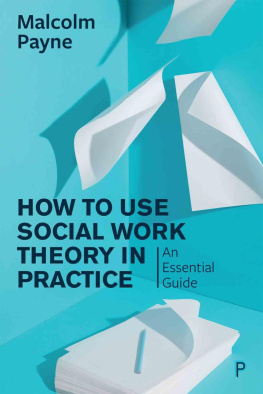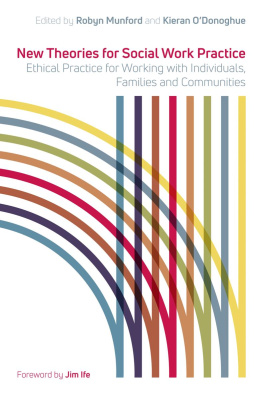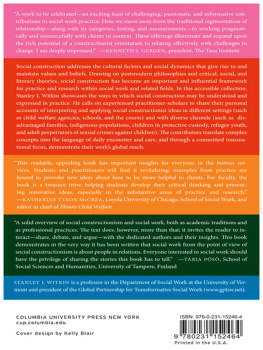An Introduction to Using Theory in Social Work Practice
An Introduction to Using Theory in Social Work Practice equips the reader to use fourteen key social work theories to guide each phase of the planned change process, from engagement through to evaluation. Suitable for a generalist approach, this book illustrates the value of applying theory to practice in a variety of social work roles, across diverse fields and facing assorted challenges.
The first section provides a practical foundation for beginning to use theory in your social work practice.
Section two looks at how you can translate and integrate fourteen theories commonly found in social work across each phase of the planned change process. The theories discussed are: behavioral, interpretive anthropology, psychodynamic, evolutionary biology, cognitive, symbolic interactionism, strengths, social constructionism, exchange economics, role, ecological, critical, feminist, and systems theory.
Sections three and four address some key issues for real-life social work practice, including common barriers to using theory in practice, the potential for multi-professional communication and theory-sharing, and developing an integrative theoretical model for your own personal practice.
Linking to core competencies identified by the Council on Social Work Education, this text supports social work students and practitioners in developing vital skills, including critical thinking, applying theory, and the effective use of the planned change process.
James A. Forte is Professor of Social Work at Salisbury University, Maryland, USA.
An Introduction to Using Theory in Social Work Practice
James A. Forte
First published 2014
by Routledge
2 Park Square, Milton Park, Abingdon, Oxon OX14 4RN
and by Routledge
711 Third Avenue, New York, NY 10017
Routledge is an imprint of the Taylor & Francis Group, an informa business
2014 James A. Forte
The right of James Forte to be identified as author of this work has been asserted by him in accordance with sections 77 and 78 of the Copyright, Designs and Patents Act 1988.
All rights reserved. No part of this book may be reprinted or reproduced or utilised in any form or by any electronic, mechanical, or other means, now known or hereafter invented, including photocopying and recording, or in any information storage or retrieval system, without permission in writing from the publishers.
Trademark notice: Product or corporate names may be trademarks or registered trademarks, and are used only for identification and explanation without intent to infringe.
British Library Cataloguing in Publication Data
A catalogue record for this book is available from the British Library
Library of Congress Cataloging-in-Publication Data
Forte, James A.
An introduction to using theory in social work practice/James Forte.
pages cm
1. Social service. 2. Social service--Great Britain. I. Title.
HV40.F672 2014
361.3'2--dc23
2013028778
ISBN13: 978-0-415-72669-6 (hbk)
ISBN13: 978-0-415-72671-9 (pbk)
ISBN13: 978-1-315-85605-6 (ebk)
Typeset in Sabon
by GreenGate Publishing Services, Tonbridge, Kent
To my studentsnear and far, young and old, recent and past, very attentive and less attentive, with thanks for their encouragement, insight, participation, openness, and patience.
Contents
Section 1
Multi-theoretical social work: basics
Section 2
Multi-theoretical social work and the planned change process
Section 3
Multi-theoretical social work across the career
Section 4
Conclusion
Knowledge sites and translation
A translation approach to theorypractice integration
Knowledge translation devices
Translation tools and the planned change process
Why translate theories for practice?
Six uses of translated theory
The person-in-environment metatheory
A generic logic model
Barriers to the integration of theory and practice
The social worker as translator and reflecting teams
Elements of an integrative multi-theoretical personal model
Overview of fourteen theories comprising PIE metatheory
Multi-theoretical social work: a person-in-environment metatheory
Translating theories to answer questions at planned change phases
Translating theories to guide the engagement phase
Translating theories to focus information gathering
Translating theories to ask information-gathering questions
Translating theories to guide the assessment formulation of explanatory hypotheses
Translating theories to guide the assessment formulation of intervention hypotheses
Translating theories to guide the goal setting process
Translating theories to specify a theory of change for intervention
Translating theories to guide the selection of intervention strategies
Translating theorists' profiles to guide the selection of intervention strategies
Translating theories to specify targets and change criteria for evaluation
Translating theories to guide the ending process
We must find a theory that will work; and that means something extremely difficult; for our theory must mediate between all previous truths and certain new experiences.
(William James, Pragmatism, 1907/1946, p. 76)
Theory and the reflective practitioner
The critical root of theory, I remind my students, is the Greek theamai, meaning I behold. In the most fundamental sense, theories enlarge our fields of observation and broaden ways of seeing, understanding, and acting. In the course of our training as social workers, I emphasize in my teaching, we must come to terms with irreducible tensions between more pure conceptions of the helping process and more limited, fragmentary renderings of what we do as we carry out our day to day practice. Although some of us are moved to search for an encompassing point of view that would promise to unify our understandings of vulnerability and problems in living, most of us come to develop a pluralist or integrative approach, refusing to privilege any single explanatory system. Grand theories, we realize, inevitably fail us as we move into the concrete particulars of our work. What is missing is certainty, we find, and the remedy lies in risk: we must carry out what Donald Winnicott called experiments in adapting to need, and have faith in the outcomes of experiential learning. Our theories are tools for thinking, as William James reminds us, and what matters is what worksthe cash value of our ideas, as he put it.
The pragmatic attitude has been a defining feature of social work, from the start of the profession, and clinicians have called upon ideas and methods across a divergent range of intellectual traditions and disciplines. Surveys show that most workers come to characterize their fundamental orientation as eclectic or integrative. And yet, as our reviews of the literature show, we continue to find remarkably little consideration of the ways in which practitioners actually engage differing theories, empirical findings, and technical procedures over the course of intervention. If we are to avoid a willy-nilly eclecticism, I have argued, we must develop an orienting perspectivewhat I think of as a home baseand formulate basic considerations and principles that guide us in our efforts to make use of differing ideas, research findings, and methods (Borden, 2010). As practitioners we must justify and defend the choices we make in light of the guiding values of the social work tradition and the particular circumstances of the clinical situation.






